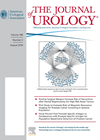
Journal Reviews
Factors and time to conversion from prostate cancer active surveillance to treatment
Active surveillance is the standard of care for men with low-risk and selected men with favourable intermediate risk prostate cancer. The aim is to reduce the morbidity and mortality of overtreatment of non-clinically significant prostate cancer. A significant proportion progress...
Increased use of active surveillance for men with intermediate risk prostate cancer
The optimal management of men with intermediate risk prostate cancer remains unclear and continues to be debated. The authors interrogate the US National Cancer Database for 176,122 men diagnosed with intermediate risk prostate cancer between 2010 and 2016. Of these...
Trade-offs between risks and benefits of localised prostate cancer treatments – the COMPARE study
We know little about the trade-offs men make when considering the oncological and functional outcomes of individual treatment options for localised prostate cancer, and decisions are often influenced by physician opinion. The likely compromised functional results are viewed as a...
Characteristics of APC and the usefulness of MP-MRI for diagnosis
The authors evaluated the pathological and oncological characteristics of anteriorly located prostate cancer (APC) in 728 RP specimens, and the accuracy of multiparametric magnetic resonance imaging (MP-MRI) for APC evaluation. Patients were characterised as APC (70% or more of tumour...







